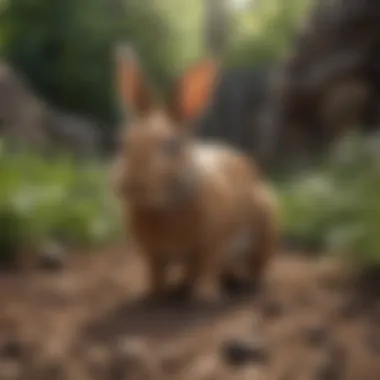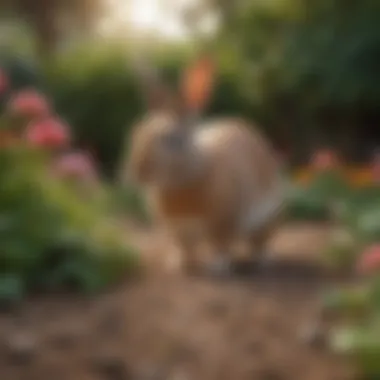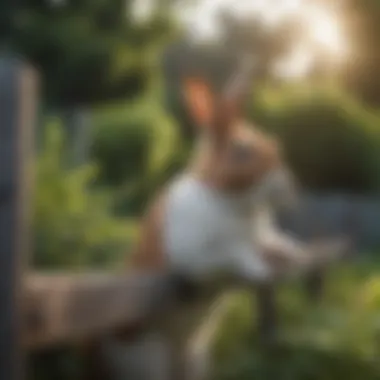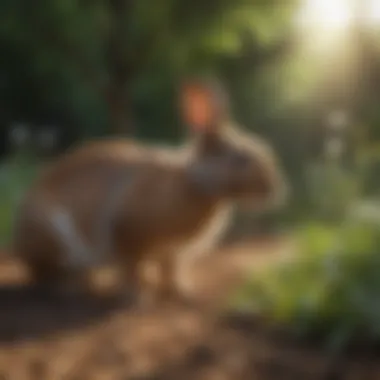Humane Strategies for Managing Rabbit Populations


Intro
Managing rabbit populations in residential yards requires both understanding and strategy. These animals can cause significant damage to gardens and landscapes if left unmanaged. Knowledge about rabbit behavior, characteristics, and humane control methods is essential. Homeowners who are informed can take steps to mitigate the impact of rabbits while ensuring their well-being. This article will outline effective strategies to manage rabbits while respecting their role in the ecosystem.
Animal Overview
Common Name and Scientific Classification
The common name for the animal is the eastern cottontail rabbit, known scientifically as Sylvilagus floridanus. This species is prevalent across North America, particularly in suburban and rural areas.
Physical Characteristics
Eastern cottontails are medium-sized rabbits with long ears and a distinctive fluffy tail. Adult rabbits weigh between two to five kilogrames, and their fur is generally brown to gray. Their prominent hind legs allow them to run quickly when threatened. The eyes are positioned on the sides of their heads, providing a wide field of vision to detect potential predators.
Habitat and Distribution
These rabbits inhabit a variety of environments, including forests, fields, and residential areas. They prefer areas with dense vegetation for cover. They are common in the eastern and midwestern United States and are adaptable to suburban settings, often found in backyards close to gardens and landscaping.
Behavior and Social Structure
Communication Methods
Eastern cottontails communicate primarily through body language and vocalizations. They may thump their hind legs as a warning to other rabbits. Soft grunts and whimpers can be heard during interactions, especially among kin.
Social Hierarchies
These rabbits are generally solitary but may form loose social groups in areas with abundant food. Dominant rabbits may claim specific territories that other rabbits will avoid.
Mating and Reproductive Behavior
The breeding season for eastern cottontails is typically from February to September. A female can have several litters, each consisting of three to eight kits. They tend to create nests in tall grass or brush for protection.
Conservation Status
Current Population Trends
Currently, the eastern cottontail population is stable. However, in some urban locations, their numbers can fluctuate due to habitat loss and increased predation.
Threats and Challenges
Rabbit populations face threats from habitat destruction, predation by domestic cats and dogs, and vehicle collisions. These factors can lead to decreased numbers in heavily urbanized areas.
Conservation Efforts and Success Stories
Conservation efforts have been initiated in certain regions. Communities are encouraged to promote local habitats that support wildlife, including the eastern cottontail. Some cities have implemented measures to enhance green spaces, allowing for a balance between urban development and wildlife.
Effective rabbit management requires understanding their role in the ecosystem alongside humane control strategies. By taking informed actions, homeowners can protect their landscapes while allowing rabbits to thrive.
Overall, a comprehensive understanding of rabbit behaviors, characteristics, and societal structures is key for homeowners seeking effective management strategies. This knowledge will inform approaches that are respectful of rabbit populations while also serving the needs of residential gardens.
Understanding Rabbit Behavior
Understanding rabbit behavior is fundamental for effective management of their populations in residential areas. This insight not only helps in recognizing the presence of rabbits but also allows homeowners to devise strategies that minimize damage to gardens and landscaping. By comprehending their natural instincts and habitat preferences, homeowners can create a more harmonious living environment while addressing potential issues.
Habitat Preferences
Rabbits typically favor areas that provide both cover and food. They thrive in meadows, gardens, and shrubs, where they can easily hide from predators. Common preferences include:
- Dense Vegetation: Rabbits prefer areas with thick shrubs or tall grass as these provide shelter.
- Open Spaces: They are also drawn to open fields for grazing, where they can find a variety of grasses and herbs.
- Moisture: Proximity to water sources can attract rabbits, as they depend on water for survival.
By understanding these preferences, homeowners can effectively manage their yard to make it less appealing for rabbits.
Feeding Habits


Rabbits are herbivores with a diverse diet, primarily consisting of grasses, leaves, and fruits. They tend to prefer:
- Tender Vegetation: Young shoots and leaves are particularly enticing to them.
- Fruits and Vegetables: Gardens that feature certain fruits and vegetables can become prime targets.
- Forbs and Weeds: Many wildflowers and weeds are also part of their diet.
Recognizing these feeding habits is critical for selecting plants that are less attractive to rabbits, thereby protecting gardens and landscapes.
Breeding Patterns
Rabbits have a remarkable ability to reproduce, which exacerbates their presence if not managed effectively. Some characteristics of their breeding patterns include:
- High Reproductive Rate: A female rabbit can give birth to multiple litters each year, with each litter having around three to twelve kits.
- Breeding Season: Their breeding season typically spans from early spring to late summer, which is crucial for planning preventive measures during these months.
- Nest Location: They often nest in hidden areas, making it challenging to identify their presence until significant damage is done.
Understanding these breeding behaviors enables homeowners to anticipate population growth and implement timely interventions.
Knowing rabbit behavior is not just about addressing an issue; it’s also about creating a more sustainable and balanced yard that respects wildlife while protecting your property.
Identifying Rabbit Presence
Identifying rabbit presence is a crucial step in managing their populations effectively in your yard. Understanding the signs that indicate whether rabbits are a source of concern can save you time and prevent potential damage to your garden. Keeping an eye on rabbit activity can help in implementing timely measures and addressing issues before they escalate.
Significant Damage Indicators
One of the most straightforward ways to identify rabbit presence is to observe any damage inflicted on your plants. Rabbits typically feast on tender shoots, young leaves, and flowers. When examining your garden, look for:
- Bite Marks: Rabbit gnawing often leaves clean, sharp edges on plant stems and leaves.
- Missing Vegetation: Areas in your garden where flowers or vegetables appear to be missing could be an indicator.
- Nibbled Grass: Short and uneven patches of grass may signify rabbit foraging activities.
Recognizing these signs early allows for prompt intervention, helping to safeguard your plants and garden environment.
Tracks and Droppings
Rabbit tracks can also reveal their presence on your property. A rabbit's foot leaves a distinct pattern in the soil or mud, usually in a circular shape with a small indentation at the front. To effectively monitor their activity, look for:
- Paw Prints: Typically, rabbit tracks show a front foot that is larger than the back foot, with three toes visible on both.
- Droppings: Rabbit pellets are small, round, and dark brown. Finding clusters of droppings near your plants or garden indicates frequent visits. Notably, these droppings can also serve as a nutrient source for soil but signal that management may be necessary.
Tracking these elements can provide valuable information about how often rabbits visit your yard and which areas are most affected.
Hiding Spots
Understanding where rabbits choose to hide can further inform your management strategies. Rabbits often seek shelter in:
- Thickets and Shrubs: Dense foliage provides cover and safety for rabbits, helping them to evade potential predators.
- Tall Grasses: Overgrown areas can become ideal nesting sites for rabbits, particularly during their breeding season.
- Garden Structures: Sheds, piles of debris, and garden furniture can create perfect hiding spots.
By being aware of these hiding spots, you can take proactive measures to reduce rabbit habitats in your yard, thus minimizing the potential for infestations. Reducing available cover can encourage rabbits to seek shelter elsewhere.
The key to effective rabbit management begins with clear identification of their presence in your area. Knowing how to spot the signs can lay the groundwork for preventing further damage.
Preventive Measures
Preventive measures are vital in managing rabbit populations effectively. These strategies focus on reducing the chances of rabbits taking residence in your yard. By employing preventive measures, homeowners can save time and effort in dealing with a burgeoning rabbit population later. This section discusses specific elements, benefits, and considerations regarding preventive methods that can help maintain a healthier garden environment.
Physical Barriers
Fencing Solutions
Fencing solutions serve as a frontline defense against rabbits. They create a physical boundary that is often effective in keeping them out. A well-constructed fence should be at least three feet tall and extend underground by about one foot. This prevents rabbits from digging under the fence. The key characteristic of fencing is its durability. Metal fencing is a popular choice because it is strong and can effectively deter rabbits. While fencing can be a costly initial investment, its long-term benefits make it a worthwhile consideration. The unique feature of fencing solutions is their versatility in design and material. However, some disadvantages include the potential need for regular maintenance and occasional repairs.
Netting and Cages
Netting and cages offer another layer of protection against rabbit intrusion. Netting can cover gardens or individual plants, allowing sunlight and rain to reach them while providing a barrier. The key characteristic of netting is its flexibility and ease of installation. It is a beneficial choice for those who want to protect specific areas without creating a full enclosure. A unique feature of netting is its ability to be cut and adjusted to size, making it suitable for various applications. However, netting can be less durable than fences and may need replacement after harsh weather conditions.
Habitat Modification
Reducing Shelter Opportunities
Reducing shelter opportunities is an effective way to deter rabbits from settling in your yard. This involves clearing debris, tall grass, and overgrown shrubs, which provide hiding spots for rabbits. The key characteristic of reducing shelter opportunities is creating an uninviting environment for rabbits. This approach is beneficial because it decreases the likelihood of rabbit populations establishing themselves in your yard. The unique aspect of this method is its simplicity; it often only requires yard maintenance. On the downside, it may require continuous effort to maintain an uncluttered yard.


Controlling Vegetation
Controlling vegetation is also crucial in managing rabbit populations. Maintaining a well-groomed yard limits the availability of food sources for rabbits. The key characteristic of controlling vegetation is to create a landscape that is less appealing to these animals. This strategy is beneficial as it can enhance the overall appearance of your yard while keeping rabbits at bay. Additionally, planting less palatable varieties of plants can discourage rabbits from seeking food in your garden. The unique feature is the dual benefit of aesthetic improvement and rabbit control. However, some homeowners may find it challenging to find the right balance between garden attractiveness and rabbit deterrence.
Natural Deterrents
Plant Selection
Plant selection is crucial in creating a rabbit-resistant garden. Choosing plants that are less attractive to rabbits can significantly reduce the chances of damage in your yard. The key characteristic of careful plant selection is understanding rabbit feeding preferences. This is a beneficial method, as it can lead to a more diverse and resilient garden. The unique aspect of plant selection is that it can be permanent, allowing you to build a garden that sustains itself against rabbit threats. However, homeowners must research and find the right balance of plants that meet their aesthetic needs.
Repellent Plants
Repellent plants can serve as natural deterrents against rabbits. By incorporating plants known to repel rabbits, you create a barrier that can help protect your garden. The key characteristic of repellent plants is their scent or taste, which is unappealing to rabbits. This method is advantageous because it combines beauty with functionality. The unique feature is that repellent plants not only fend off rabbits but can also attract beneficial insects. However, the effectiveness of these plants can vary depending on the specific rabbit population and their feeding behavior.
Humane Control Methods
Humane control methods offer a compassionate approach to managing rabbit populations in residential areas. These methods are essential for homeowners who seek effective solutions without resorting to lethal measures. Utilizing humane techniques preserves ecological balance while providing a means to protect gardens and landscapes from rabbit damage.
Trapping Techniques
Types of Traps
Trapping techniques are fundamental to humane control. There are various types of traps available, with live traps being a prominent choice. Live traps, such as the Havahart trap, allow for the capture of rabbits without causing harm. This is beneficial as it aligns with ethical considerations in wildlife management.
The unique feature of live traps is their design, which typically includes a mechanism that closes the entrance once the rabbit enters, ensuring that the animal remains unharmed. Although they are popular, it is important to recognize potential challenges. Live traps require regular monitoring to prevent undue stress to the captured rabbits and to promote swift relocation.
Proper Trap Placement
The placement of traps is critical for their success. Proper trap placement involves strategic positioning in areas with high rabbit activity, such as near burrows or feeding sites. This characteristic increases the likelihood of capture, contributing to effective population control.
A unique feature of proper trap placement is that it often requires careful observation of rabbit behavior and habitat. Ensuring traps are placed where rabbits are likely to travel can improve capture rates significantly. However, misplacing traps can lead to wasted effort and cause frustration for the homeowner.
Relocation Considerations
Local Regulations
Understanding local regulations regarding wildlife relocation is imperative. Many regions have specific guidelines that dictate how and where captured animals can be relocated. A key characteristic of these regulations is the emphasis on ethical and responsible wildlife management. This guideline is beneficial in preventing disruptions in local ecosystems or introducing disease to new areas.
The unique feature of these regulations often includes fines or penalties for improper handling of wildlife. Compliance with local laws not only protects the homeowner but also demonstrates respect for community wildlife guidelines.
Selecting Appropriate Release Sites
When considering relocation, selecting appropriate release sites is equally important. This involves choosing areas that can sustain the rabbit population, ensuring their survival. A main characteristic of suitable release sites is the availability of shelter and food resources, which contribute to successful reintegration into the wild.
The unique feature here is that careful research is required to find locations that meet these criteria. Improper release sites may lead to high mortality rates in rabbits unable to adapt. Therefore, identifying safe, sustainable habitats is crucial in wildlife management efforts, reflecting the overall goal of maintaining ecological harmony.
Companion Animals and Rabbits
Companion animals, particularly dogs and cats, play a significant role in managing rabbit populations in residential settings. Their natural predatory instincts can be a useful tool in discouraging rabbits from frequenting your yard. This section will delve into the various ways companion animals can contribute to a peaceful coexistence with wildlife, focusing on the benefits and precautions needed to ensure that such a strategy is successful.
Role of Dogs and Cats
Training Dogs as Deterrents
One key aspect of using dogs as a deterrent lies in their training. Some dog breeds possess a higher instinct for chasing small animals, making them effective in scaring rabbits away from your garden. Training a dog to recognize and respond to the presence of rabbits is not overly complex. It usually involves positive reinforcement when the dog shows interest in tracking or chasing them (while ensuring safety).
The advantage of this method is that it leverages the dog's natural behavior without resorting to harmful tactics. However, it is crucial to note that not all dogs will react the same way; some might just want to play. It’s advisable to assess the individual dog's temperament before relying on them for this purpose.
Supervised Interactions with Cats
Cats also have their role, but it is more about how they interact with the environment. Allowing cats outside to roam can pose both benefits and risks, depending on the area. Supervised interactions can help maintain a controlled setting where cats can explore safely without becoming a direct threat to rabbits.
This strategy can be beneficial because it allows cats to exhibit their natural hunting behavior without creating chaos in the environment. However, care must be taken to ensure that cats do not harm rabbits or pose threats to local wildlife. Keeping interactions supervised means you can also protect your pets from potential hazards.


Protective Strategies for Pets
When employing companion animals as a means to manage rabbit populations, protective strategies for pets become essential. Ensuring the safety of dogs and cats around wild rabbits includes the following practices:
- Supervision: Always supervise pets while outside. This lets you intervene if necessary, providing a safer environment.
- Health Checks: Ensure pets are up to date on vaccinations to prevent disease exposure from wildlife.
- Controlled Environment: Using leashes or a controlled outdoor space like a kennel can prevent unwanted encounters while still allowing pets outdoor time.
Overall, the use of companion animals as part of a comprehensive rabbit management strategy can be effective. A balanced approach that considers the needs of both wildlife and your pets fosters a harmonious environment in your yard.
Long-term Management Practices
Managing rabbit populations effectively requires a strategic approach that extends beyond immediate solutions. Long-term management practices are essential for maintaining balance in your yard and ensuring the health of your garden ecosystem. Understanding the patterns of rabbit behavior, their breeding cycles, and the factors that attract them to your area can help in formulating lasting solutions. This proactive stance not only minimizes damage but also promotes a harmonious co-existence with wildlife.
Monitoring Rabbit Activity
Regularly monitoring rabbit activity provides critical insights into their behavior. Homeowners should keep track of the number of rabbits present and their feeding habits. Information such as the frequency of sightings and signs of damage to plants can help gauge whether intervention is necessary.
Setting up cameras or keeping a log can be effective methods for monitoring. This data can reveal patterns that may not be immediately apparent, such as peak feeding times or areas of heavy activity. Moreover, evaluating the effectiveness of implemented management techniques becomes simpler when there is consistent data available.
Community Involvement
Community involvement plays a vital role in managing rabbit populations. Involving neighbors can create a more comprehensive approach to addressing the issue, as rabbits often traverse property lines.
Cooperative Solutions
Cooperative solutions focus on working collaboratively with neighbors to manage rabbit populations. This approach benefits communities by creating a united front against the common challenges posed by rabbits. Neighbors can share resources, such as fencing materials or deterrents, making management more efficient and cost-effective.
One key characteristic of cooperative solutions is the shared knowledge among community members. By discussing what works and what does not, residents can avoid redundant efforts and enhance their strategies.
Benefits of Cooperative Solutions:
- Resource sharing reduces individual expenses.
- Increased chances of successful implementation due to combined efforts.
However, challenges can arise when neighbors may have different attitudes towards wildlife. It's important to communicate clearly and ensure all parties are on the same page regarding management goals.
Educating Neighbors
Educating neighbors about rabbit behavior and management techniques is essential. When a community is informed, it fosters a sense of responsibility. Neighbors learn to identify signs of rabbit presence and understand the importance of implementing preventive measures.
A key characteristic of educating neighbors is the cultivation of awareness and proactive behavior. Workshops or neighborhood meetings can be organized, allowing everyone to share experiences and solutions. This effort can help in building community spirit while addressing rabbit-related challenges.
Advantages of Educating Neighbors:
- Enhanced community cohesion.
- Improved effectiveness of management strategies across properties.
However, some challenges include differing levels of interest among residents. A lack of engagement from some neighbors can limit the effectiveness of educational efforts. Thus, finding compelling ways to present information is vital to encourage participation.
Case Studies and Success Stories
Understanding the effectiveness of different strategies to manage rabbit populations can be greatly enhanced by examining case studies and success stories. These real-life accounts not only illustrate practical applications of various methods but also reveal the context and conditions that led to successful outcomes. By studying these examples, homeowners and wildlife managers can glean insights on what works, what doesn't, and why.
Analyzing documented experiences provides valuable information about the specific approaches taken, the challenges faced, and the results achieved. It allows for a better understanding of how different environments—whether urban or rural—impact rabbit control effectiveness. Additionally, these studies can inspire confidence in those seeking solutions while underscoring the importance of tailored strategies to unique situations.
End and Best Practices
Managing rabbit populations in residential yards is a critical endeavor for homeowners. It balances the need to protect gardens with the ecological value that rabbits can provide. This section summarizes effective strategies while considering future implications for continuous management.
Summary of Recommendations
To effectively manage rabbit populations, homeowners should consider implementing the following strategies:
- Physical Barriers: Erect fences and netting to deter rabbits from accessing gardens. Ensure that fences are tall enough and buried underground to prevent burrowing.
- Habitat Modifications: Simplify the area for rabbits by removing dense shrubbery and other potential hiding spots. Control vegetation to limit food availability.
- Natural Deterrents: Use plants that are known to repel rabbits. For example, herbs like mint and plants with strong odors.
- Humane Control Methods: If rabbit populations become excessive, consider trapping and relocating them humanely.
- Community Involvement: Work with neighbors to establish best practices and solutions that benefit the entire area.
By combining these tactics, residents can create an environment that is less inviting to rabbits, safeguarding their plants without resorting to harmful methods.
Future Considerations
The approach to rabbit management should evolve as the ecological landscape and community contexts change. Here are some future considerations:
- Monitoring Changes: Regularly assess rabbit activity and any changes in their behavior. This practice helps in adapting management strategies promptly.
- Engaging with Wildlife Experts: Keeping in touch with local wildlife biologists or veterinarians can provide insights on effective practices and the ecological significance of managing rabbit populations.
- Sustainable Practices: Consider implementing sustainable gardening practices that create a balanced ecosystem, allowing for coexistence with rabbit populations.
- Policy Awareness: Stay informed about local wildlife regulations and community initiatives that may influence rabbit management.
By focusing on these areas, homeowners can develop a proactive strategy to manage rabbits effectively and sustainably in their yards.







